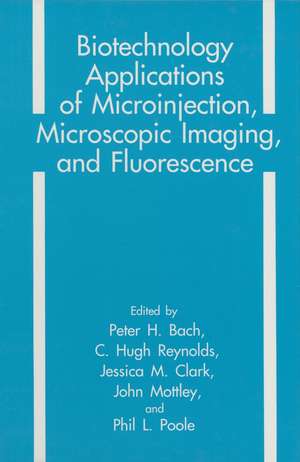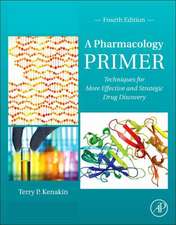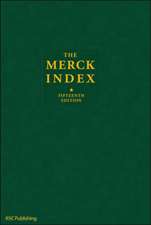Biotechnology Applications of Microinjection, Microscopic Imaging, and Fluorescence
Editat de Peter H. Bach, C. H. Reynolds, J. M. Clark, J. Mottley, P.L. Pooleen Limba Engleză Paperback – 28 oct 2012
Preț: 369.84 lei
Preț vechi: 389.31 lei
-5% Nou
Puncte Express: 555
Preț estimativ în valută:
70.78€ • 76.85$ • 59.45£
70.78€ • 76.85$ • 59.45£
Carte tipărită la comandă
Livrare economică 22 aprilie-06 mai
Preluare comenzi: 021 569.72.76
Specificații
ISBN-13: 9781461362234
ISBN-10: 1461362237
Pagini: 276
Ilustrații: XI, 255 p.
Dimensiuni: 170 x 244 x 14 mm
Greutate: 0.45 kg
Ediția:Softcover reprint of the original 1st ed. 1993
Editura: Springer Us
Colecția Springer
Locul publicării:New York, NY, United States
ISBN-10: 1461362237
Pagini: 276
Ilustrații: XI, 255 p.
Dimensiuni: 170 x 244 x 14 mm
Greutate: 0.45 kg
Ediția:Softcover reprint of the original 1st ed. 1993
Editura: Springer Us
Colecția Springer
Locul publicării:New York, NY, United States
Public țintă
ResearchCuprins
Microinjection: A Technique to Study Inhibition of HIV-1 Replication Mediated by Antisense RNA and Parvovirus genes.- How to Make Glass Microtools for the Injection of Isolated Plant Sperm Cells into Embryo Sac Cells Using a Microforge.- Application of the Firefly Luciferase Reporter Gene to Microinjection Experiments in Xenopus Oocytes.- Application of Confocal Microscopy for the Study of Neuronal Organization in Human Cortical Areas After Microinjection of Lucifer Yellow.- The Dye-Transfer Assay Permits the Evaluation of the Modulation of Junctional Communication by Chemicals: Results Obtained Employing a Highly Sensitive Video-Recording System Connected with the Microinjector.- Comparison of Fluorescent Dye Transfer in Intercellular Communication Studies Using Scrape-Loading and Microinjection Techniques.- Characterization of the Zea mays Embryo Sac Using Fluorescent Probes and Microinjection of Lucifer Yellow into the Female Cells.- Fluorescent Probes — Where Do They Go in Cells, and Why?.- Fluorescent Phospholipids in Membrane and Lipoprotein Research.- Selection of Fluorescent Golgi Complex Probes Using Structure-Activity Relationship Models.- Fluorescent Probes for the Assessment of the Subcellular Effects of Chemicals and Disease Processes In Vivo and In Vitro.- Whole-Cell Patch-Clamping: Introducing Substances into Cells During Electrical Measurements from the Cell Membrane: A Review of Potential Difficulties in Plant and Animal Cells.- Fluorescent Analysis of Replication and Intermediates of Chromatin Folding in Nuclei of Mammalian Cells.- Autofluorescence in Potato Tuber Phellum: Location and Time Course of Appearance During Tuber Formation.- Flow Cytometric Assessment of Gentamicin Nephrotoxicity in Established Renal Cell Lines.- The Use of the FluorescentProbe Fura-2 for Intracellular Free Calcium Measurements: Some Methodological Aspects.- Studies on the Effects of Peroxisome Proliferators as Novel Ca2+ Mobilizing Agents using Indo-1-Loaded Hepatocytes.- Confocal Fluorescence Ratio Imaging of pH in Plant Cells.- Analysis of the Calcium and Phosphorus Distribution in Predentine Tissue of Rat Incisors.- Quantitative Localisation of HIV Proteins in Mammalian Cells.- Concepts of the Cytometric Approach.- Laser Microperforation of Medicago sativa Root Hair Cells.- Application of pH-sensitive Fluorescent Dyes to Fungi.- Very Low Level Fluorescence Detection and Imaging Using a Long Exposure Charge Coupled Device System.- Modulation of Nucleus Formation in Mouse Oocytes Fused with Early and Late G2 Blastomeres.







